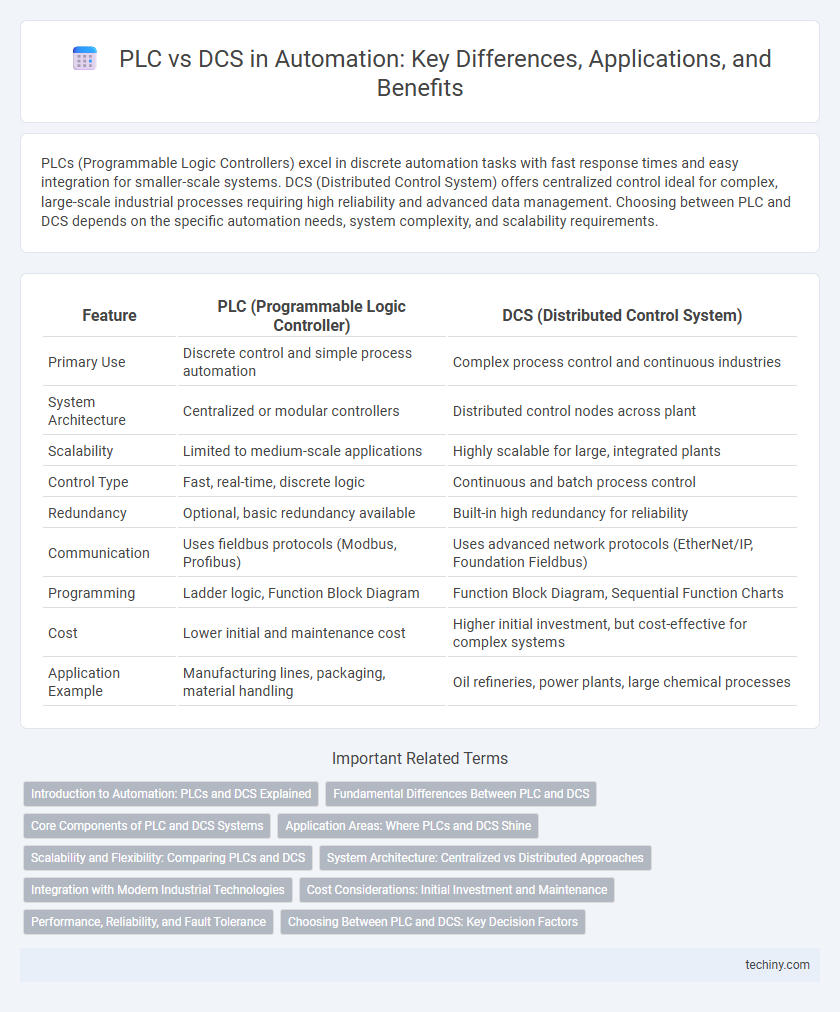PLCs (Programmable Logic Controllers) excel in discrete automation tasks with fast response times and easy integration for smaller-scale systems. DCS (Distributed Control System) offers centralized control ideal for complex, large-scale industrial processes requiring high reliability and advanced data management. Choosing between PLC and DCS depends on the specific automation needs, system complexity, and scalability requirements.
Table of Comparison
| Feature | PLC (Programmable Logic Controller) | DCS (Distributed Control System) |
|---|---|---|
| Primary Use | Discrete control and simple process automation | Complex process control and continuous industries |
| System Architecture | Centralized or modular controllers | Distributed control nodes across plant |
| Scalability | Limited to medium-scale applications | Highly scalable for large, integrated plants |
| Control Type | Fast, real-time, discrete logic | Continuous and batch process control |
| Redundancy | Optional, basic redundancy available | Built-in high redundancy for reliability |
| Communication | Uses fieldbus protocols (Modbus, Profibus) | Uses advanced network protocols (EtherNet/IP, Foundation Fieldbus) |
| Programming | Ladder logic, Function Block Diagram | Function Block Diagram, Sequential Function Charts |
| Cost | Lower initial and maintenance cost | Higher initial investment, but cost-effective for complex systems |
| Application Example | Manufacturing lines, packaging, material handling | Oil refineries, power plants, large chemical processes |
Introduction to Automation: PLCs and DCS Explained
PLCs (Programmable Logic Controllers) and DCS (Distributed Control Systems) are essential automation technologies designed to control industrial processes efficiently. PLCs excel in discrete control applications with fast processing speeds and modular hardware, making them ideal for manufacturing lines. DCS offers integrated control for complex continuous processes, providing centralized monitoring and advanced data management for large-scale plants.
Fundamental Differences Between PLC and DCS
PLCs (Programmable Logic Controllers) are designed for discrete control tasks, offering high-speed, real-time processing and modularity suited for individual machine automation. DCS (Distributed Control Systems) provide integrated control over continuous processes with complex data management and scalability across entire plants, emphasizing centralized monitoring with distributed control nodes. Key differences lie in their architecture, with PLCs optimized for fast, local control and flexibility, while DCS excels in process integration, redundancy, and comprehensive system coordination.
Core Components of PLC and DCS Systems
PLC systems rely on a central processor, input/output modules, and communication interfaces to execute discrete control tasks with high-speed processing. DCS architecture incorporates multiple controllers, operator stations, and a communication network to enable distributed processing and centralized monitoring for complex industrial processes. Both systems use sensors and actuators as fundamental components, but PLCs emphasize modular hardware design while DCS emphasizes system integration and scalability.
Application Areas: Where PLCs and DCS Shine
PLCs excel in discrete manufacturing environments such as automotive assembly lines and packaging systems, offering fast, precise control for sequential processes. DCS is ideal for continuous or batch processing industries like oil refining, chemical production, and power generation, providing integrated control, advanced process monitoring, and scalability. Both systems optimize automation by aligning their strengths with specific operational demands, improving efficiency and reliability.
Scalability and Flexibility: Comparing PLCs and DCS
PLCs offer high flexibility and scalability for discrete control applications with modular hardware and software configurations, enabling easy expansion and customization for smaller or medium-sized systems. DCS systems provide superior scalability and centralized control for complex, continuous process industries, integrating multiple control loops and advanced process management over large-scale operations. While PLCs excel in rapid deployment and adaptability, DCS delivers robust scalability and flexibility for extensive process automation environments.
System Architecture: Centralized vs Distributed Approaches
PLC systems typically use a centralized architecture where control logic is executed on individual controllers linked directly to field devices, offering fast response times for discrete control tasks. DCS employs a distributed architecture distributing control functions across multiple controllers connected through a high-speed network, enabling integrated process automation and scalability in complex operations. The centralized PLC approach excels in focused, modular control, while DCS's distributed system architecture supports real-time data sharing and fault tolerance across large plants.
Integration with Modern Industrial Technologies
PLC systems excel in integrating with modern industrial technologies such as IoT devices, cloud computing, and edge analytics due to their modular design and real-time processing capabilities. DCS offers seamless integration with large-scale industrial processes and advanced control strategies, supporting extensive data communication protocols and cybersecurity standards for critical infrastructure. Both systems incorporate Industry 4.0 principles, but PLCs provide greater flexibility for discrete automation, while DCS is optimized for continuous process control and centralized monitoring.
Cost Considerations: Initial Investment and Maintenance
PLCs typically require a lower initial investment compared to DCS systems due to their modular design and simpler hardware requirements. Maintenance costs for PLCs are generally less expensive given easier troubleshooting and replacement of discrete components. DCS systems, while more costly upfront, offer integrated diagnostics and scalability that can reduce long-term operational expenses in complex automation environments.
Performance, Reliability, and Fault Tolerance
Programmable Logic Controllers (PLCs) excel in high-speed, discrete control tasks with rapid response times, making them ideal for machine-level automation, while Distributed Control Systems (DCS) offer superior performance in complex process control with extensive data handling capabilities. DCS architectures provide enhanced reliability through redundant controllers and communication networks, reducing system downtime in critical industrial operations. Fault tolerance in DCS is generally higher due to built-in diagnostic tools and modular components that allow seamless hot-swapping, whereas PLC fault tolerance depends on the specific model but typically involves simpler recovery mechanisms.
Choosing Between PLC and DCS: Key Decision Factors
Choosing between a PLC and a DCS depends on the scale and complexity of the automation project, with PLCs excelling in discrete control tasks and smaller systems, while DCS offers superior performance for large-scale, continuous processes requiring integrated control and monitoring. Key decision factors include system architecture, process complexity, scalability, and real-time data management requirements. Cost considerations, ease of programming, and maintenance also play crucial roles in determining the optimal control system for industrial automation applications.
PLC (Programmable Logic Controller) vs DCS (Distributed Control System) Infographic

 techiny.com
techiny.com